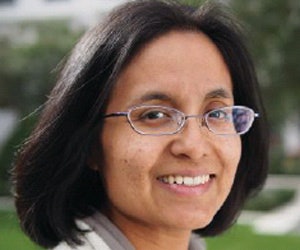Back when she was a first-grader — and long before she found herself in a Utah gully staring at the discovery of a lifetime — Dr. Marina Suarez used to find herself drawn to a large chunk of fossil located in the schoolyard at Boone Elementary School in San Antonio.
“We used to try to dig it out because it had little shells and things,” Suarez recalls. “We didn’t have any digging tools so I used bits of pencils and pens and things we got from the cafeteria and tried to get things out.
 Dr. Marina Suarez
Dr. Marina Suarez“Our teacher would shoo us away and say, ‘Get out of the dirt!’ Then she would go off and we would keep working on it.”
Even at the family home, Suarez and her identical twin sister, Celina, would use their father’s tools to dig holes in their backyard in a quest to find dinosaur bones.
“I always wanted to be a scientist and professor, and it’s kind of silly but I was a big fan of Indiana Jones when I was little,” Suarez says of the fictional archaeology professor whose adventures were featured in a series of movies in the 1980s.
“I was like, ‘Oh, man, if that’s what it’s like to be a professor — all those adventures — I want to be a professor,” Suarez says.
Today, that childhood dream has become a reality. Suarez is an associate professor of geology at the University of Texas at San Antonio.
She says the “apex” of her career began in 2016, when she won a $478,000 Faculty Early Career Development award — also known as a CAREER award — from the National Science Foundation to support her research in paleoclimatology.
“Those are very competitive,” she says of the NSF CAREER grants. “They’re hard to get.”
Suarez’s grant project is slated to continue through 2021. She is using her funding to study the climate changes during the Cretaceous Period — which is widely known for the various dinosaur fauna.
“By understanding ancient terrestrial carbon cycle perturbations, we can understand the consequences to ongoing disruptions to the carbon cycle,” a description of her project states. “Th is project will determine if the Cretaceous carbon cycle disruptions resulted in temperature and precipitation changes on land.”
Suarez is also using the funds to support community college, undergraduate, graduate and post-doctoral students and to create educational lab activities.
Suarez plans to collaborate with other universities and create a “strong research program for professional development that will provide a solid base for future research,” the description states.
Suarez says she would not be where she is today were it not for her twin sister, who is an assistant professor in the Department of Geosciences at the University of Arkansas.
“A lot of people ask me, ‘How did you end up getting through university and what not and maintain your interest and everything?’” Suarez says. “And I guess I would say that having a twin sister was really helpful. We were both interested in similar stuff . I always had a study buddy.”
Indeed, Suarez and her sister both attended the same colleges. Aft er attending Trinity University in San Antonio for their undergraduate studies, they went to Temple for their graduate studies and then to the University of Kansas for their Ph.D.s. All of their degrees are in geology.
The pair was together as Temple University graduate students for what became the most exciting event in Suarez’s geological career. They were both surveying a gully in Utah when they noticed some bones — including what appeared to be rib bits — on the side of a cliff . It ended up being a dinosaur — and a childhood dream come true.
“I was super excited because when I was a little kid that was what I wanted to do — find new dinosaur sites,” Suarez says. Now, Suarez and her sister’s names are permanently etched in dinosaur history.
Since the site was discovered by the Suarez twins, officials at the Utah Geological Survey named one of the dinosaurs from the site Geminiraptor suarezoraum, which means “Suarez’s twin raptor,” Jim Kirkland, state paleontologist with the Utah Geological Survey, told Diverse.
“Both are exceptional paleogeochemists providing key insights into Mesozoic paleontology and paleoclimatology,” Kirkland says of the Suarez twins. “They are superstars of STEM.”
Suarez credits her mother with laying the foundation for her academic success.
“My mom is a teacher, and so she always kind of understood the importance of reading and books,” Suarez says. “So we used to go to the museum, the zoo and what not, and we used to go to the library all the time,” Suarez says, recalling how she used to go to the section focusing on fossils and rocks and pull out all the books on those subjects.
Though Celina Suarez is the oldest of twins by two minutes, Marina Suarez says she was the first to get hired as a professor. “So I hold that over her head,” Suarez says.
Dr. Marina Suarez
Title: Associate Professor of Geology, University of Texas at San Antonio
Tenured: Yes
Education: B.S., Trinity University; M.S., Temple University; Ph.D., University of Kansas
Age: 36
Career mentors: Edward C. Roy, Trinity University; Dennis O. Terry, Temple University; Luis A. Gonzalez, University of Kansas; Gregory A. Ludvigson, University of Kansas and Kansas Geological Survey; Benjamin Passey, University of Michigan.
Words of wisdom/advice for new faculty members: Prioritize time and learn the art of saying ‘no’ to some requests.


















